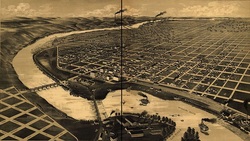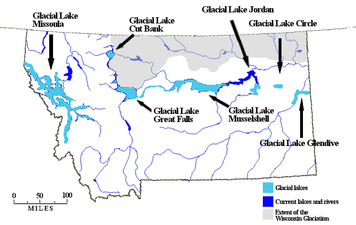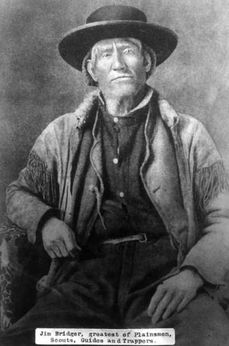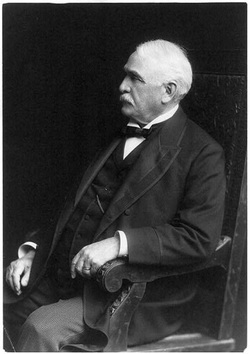 Great Falls, 1891
Great Falls, 1891
Whites came in the early 1800s and beginning in the 1880s the city of Great Falls was laid out and planned. Most of that work could be put at the feet of one man, Paris Gibson, the founder of Great Falls, Montana.
A Watery Origin

The lake has its origins around 1.5 million years ago. During that time the Laurentide and Cordilleran ice sheets were formed. Over time these would push southward until around 15,000 to 11,000 BC when they blocked off the Missouri River and created Lake Great Falls.
The lake was 3,900 feet above sea level and beginning around 13,000 BC the ice sheets and glaciers retreating eventually caused Lake Great Falls to burst out of its confinement and tear through the Highwood Mountains, about twenty-three miles from the current city of Great Falls, creating the Shonkin Skag.
The Shonkin Skag is a prehistoric meltwater channel that runs 100 miles from Highwood, Montana, to the Judith Basin. It’s 500 feet deep and reaches a width up to two miles in some spots, and just 0.25 in others.
People Begin to Arrive
 Jim Bridger
Jim Bridger
The area saw the first whites, probably with European explorers in the late 18th century, and then Lewis and Clark in 1805. Jim Bridger explored the area quite a bit around 1822, and it was there on the Andrew Henry Expedition of April, 1823, that he and many others came under attack from Blackfeet Indians.
In 1838 Jim Bridger guided a mapping expedition to the area at the behest of the federal government, and he’d go on to spend four years in the area. Not much happened after that until 1859 when the first steamboat came up to where the city would lay.
Settlers began coming to the area, although not in large numbers. When the Hellgate Treaty was signed with the Blackfeet in 1855 fewer attacks against whites occurred, so more came, but still not in any great numbers. It wouldn’t be until someone from Maine came through in 1880 that all of that would change.
Paris Gibson: The Founder of Great Falls
 Paris Gibson, 1901
Paris Gibson, 1901
After a time he moved to Minnesota, where he once again became active in his community. First he built the North Star Woolen Mill at St. Anthony’s Falls, and even served on the University of Minnesota Board of Regents from 1871 to 1879.
By 1880 things weren’t going that well in Minnesota so he headed even further west from his native Maine, reaching the Great Falls of the Missouri River later that year.
Gibson convinced his friend James J. Hill to invest in a townsite there at the falls, as well as to steer his railroad through. Both actions ensured a city would spring up, and by 1883 the city of Great Falls was founded.
Things moved quickly after that. The first citizens arrived in 1883 and in 1884 a flower mill, several stores, and a number of houses were built. That July the post office was established, with Gibson serving as the first postmaster. By 1885 a lumber yard and planning mill had been constructed, as well as a bank, school, and newspaper, the Great Falls Tribune.
All of those changes encouraged people to come, but perhaps not as much as the Great Northern Railway moving through the city, which occurred in 1887. This linked Great Falls by rail to the other emerging metropolises of the territory, Butte and Helena. The main line that Hill had built, however, was far to the north of Great Falls.
Still, because of those changes, and just four years after its start, Great Falls had 1,200 citizens. The next year saw the city officially incorporate, on November 28, 1888.
Efforts were soon underway to harness the might of the river. In 1890 the Black Eagle Dam was built. That same year saw the city reach a population of 3,949 residents according to the U.S. Census.
More dams would follow, including the Rainbow Dam in 1910 and Volta Dam in either 1912 or 1915. Volta Dam would be renamed Ryan Dam in 1940 in honor of Montana Power Company Founder John D. Ryan).
The city made do, finding other ventures. It became a hub for farmers, traders, and ranchers and the hydro power of the river was soon harnessed as well. Processing plants for ore and mills for grain were soon in operation.
The people of Great Falls and Montana recognized the work Gibson had done for them, and elected him to fill the seat of William A. Clark when he resigned his seat on May 15, 1900, to avoid charges of election fraud. The seat would remain vacant for nearly a year until Gibson was appointed to fill it.
Gibson served in the Senate from March 7, 1901, to March 3, 1905 and never sought re-election, instead spending the rest of his days in Great Falls. He died on December 16, 1920. He was 90 years old.
Notes
Alt, David and Hyndman, Donald W. Roadside Geology of Montana. Mountain Press Publishing: Missoula, 1986.
Axline, Jon and Bradshaw, Glenda Clay. Montana's Historical Highway Markers. Montana Historical Society: Helena, 2008.
Federal Writers' Project. Montana: A State Guide Book. Federal Works Agency, Work Projects Administration: Washington, D.C., 1939.
O'Neal, Bill. Fighting Men of the Indian Wars: A Biographical Encyclopedia of the Mountain Men, Soldiers, Cowboys, and Pioneers Who Took Up Arms During America's Westward Expansion. Barbed Wire Press: Stillwater, 1991.

